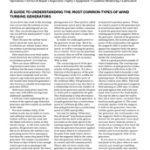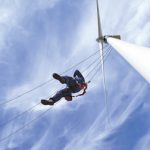In our industry, many of the wind turbines are more than 150 feet tall, and technicians often scale the turbine to perform routine maintenance and repairs on a daily basis. Being physically fit and having the ability to climb those heights are primary criteria for any wind technician.
You might think climbing daily would be enough to keep you fit. However, many studies have shown that if you are not taking care of yourself outside of the workplace, you are more prone to injuries in the workplace.
Below are some of the most important things you can do to outside of work to help keep yourself healthy and fit for those daily climbs.
Cardio
Cardiovascular exercise is important as it helps to strengthen the heart and lungs for that daily climb. Your daily climb—especially when gear, weather, stress, and protective clothing factor in—can tax the cardiovascular system of even the healthiest individuals. Some of the things that you can do to keep your heart healthy for work can be something as simple as walking. Even a brisk one-mile walk just a few times a week can provide great benefits. The conditioning and health of the heart and blood vessels are the basis for safety and performance in nearly all physical or athletic endeavors.
Strength
Strength training helps to strengthen the muscles that you use to climb, and will help keep your knees sound and your anterior cruciate ligaments (ACL) intact. The function of the ACL is to provide stability to the knee and minimize stress across the knee joint. Damage to the ACL, then, will cause climbing to be painful, and in more severe cases can make climbing impossible. Studies have shown that repetitive motion is the most common cause of knee injuries.
If you keep your knees and the muscles, tendons and ligaments surrounding the knees healthy, strong, and sound, you reduce your risk of injury. With strength training, as you progressively train and increase the load on a specific joint, the muscles, tendons, and ligaments all adapt and get stronger. As strength rises, so does the joint’s resistance to injury.
Stretching
Stretching helps to reduce the risk of injury by increasing flexibility. When you incorporate stretching into your exercise routine or prior to a climb, it is important to follow certain guidelines while stretching to avoid any onset of injury. Many believe stretching is considered a warm-up. However, the opposite is true; stretching cold muscles can make you prone to injury. Recent research has shown that stretching before exercise may actually make muscles contract and become shorter, rather than loosening muscles, which is obviously the desired effect. Instead of beginning with a traditional stretching routine, like bending over and touching your toes, experts recommend walking in place with high knee lifts, for instance, to simulate the climbing action, prior to the traditional stretching. This gets the blood flowing and primes the specific muscles that will be used in the stretch and subsequent climb.
According to MayoClinic.com, avoid any bouncing-type movements; these can cause small tears in your muscles. When stretching, you should hold the stretch for 30 seconds before releasing. It is important to stretch both sides of your body. For example, if you stretch your right quadriceps, you should also stretch your left quadriceps.
Hydration
Hydration is not only important on those hot days. Being properly hydrated year round holds many benefits. Water helps transport oxygen and other essential nutrients to your cells, which can help the body to fight fatigue. Your brain is 85 percent water; if you’re dehydrated, both your body and your mind will feel stressed. Sufficient levels of water in your system will reduce muscle cramps and will increase lubrication in the joints of the body; water is also the most natural cleanser for our organs and digestive system. Recommended intake of water is 64 ounces daily—more if physical exertion is occurring. Caffeinated and sugary drinks such as coffee and soda can actually reduce your hydration levels.
Following your company’s safety policies and climbing procedures, eating right and having a good routine outside of work will keep you fit and ready for that hard day of work that lies ahead.
Stay safe, my friends!








































